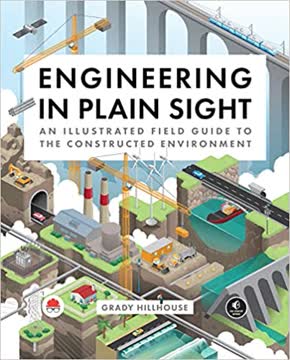Key Takeaways
1. Engineering is Everywhere: See the World Through an Engineer's Eyes.
Each and every class was like turning on a lamp to illuminate some innocuous part of the constructed environment that I had never noticed before.
A new perspective. The author's journey into civil engineering wasn't just about learning math and science; it was about gaining a completely new way of seeing the world. Suddenly, everyday objects like beams, electrical lines, and drains transformed from mundane background elements into fascinating examples of problem-solving and ingenuity. This shift in perspective reveals the hidden complexity and wonder in the infrastructure that silently supports our modern lives.
Monuments to solutions. Even the most ordinary parts of the built environment are not accidental; they are deliberate solutions to practical engineering challenges. Understanding these challenges and how they were overcome can instill a sense of astonishment and wonder. From the design of a simple utility pole to the layout of a city street, every element is a testament to human effort and intelligence aimed at making our lives safer, easier, and more connected.
An illustrated guide. This book serves as a field guide to help readers develop this same perspective, pointing out the details and complexities of the constructed world that are often overlooked. It encourages a treasure hunt for the interesting bits and bobs of infrastructure, fostering curiosity and appreciation for the engineering feats surrounding us. By learning to identify and understand these elements, the seemingly plain becomes extraordinary.
2. The Electrical Grid: An Instantaneous, Interconnected Lifeline.
Unlike other utilities, electricity is quite challenging to store on a large scale, which means power must be generated, transported, supplied, and used all in the same moment.
A vast network. The electrical grid is a massive, interconnected system spanning continents, instantly moving power from where it's generated to where it's needed. This complex dance of generation, transmission, and distribution relies on perfect synchrony between producers and users, constantly adjusting output to match fluctuating demand. Substations act as critical hubs, transforming voltage levels and providing protection against faults.
Efficiency and safety. High voltage is used for long-distance transmission to minimize energy loss due to resistance, but this requires keeping conductors far from human activity on tall towers. These towers, insulators, and shield wires are visible signs of the grid's high-voltage backbone. Distribution lines then step down the voltage for local delivery, carried on ubiquitous utility poles alongside other services, requiring careful management of safety and reliability.
Visible components. Much of the grid's equipment is in plain sight, from thermal power station stacks and wind turbines to transmission towers, substations, and utility poles. Observing these elements reveals the engineering required to keep power flowing:
- Transformers boosting or lowering voltage.
- Insulators preventing dangerous arcs.
- Circuit breakers isolating faults.
- Arresters protecting against lightning.
- Bundled conductors increasing efficiency.
3. Communications Networks: Connecting the Globe Through Visible and Invisible Paths.
No other part of society seems to be changing more rapidly than our communications technologies.
Beyond shouting distance. Telecommunications infrastructure enables us to share information across vast distances, constantly evolving from early copper wires to modern fiber optics and wireless signals. This intricate web relies on both physical lines strung overhead or buried underground and invisible radio waves transmitted through the air. Identifying the different cables on a utility pole or the cabinets along a street reveals the layers of technology connecting us.
Overhead and underground. Physical communication lines, including telephone, cable TV, and fiber optics, often share utility poles with electrical distribution lines, occupying the lowest, safest space. Underground lines, while hidden, surface at cable vaults, communications cabinets, and pedestals, offering clues about the network below. These buried systems are more expensive but less obtrusive and better protected from weather.
Wireless infrastructure. Radio communication relies on antennas mounted on tall towers or structures to extend signal range. Cellular networks subdivide areas into "cells," using numerous base stations with directional antennas to manage billions of daily transmissions. Satellite communication extends reach globally using orbiting relays and large ground-based dishes. Observing these towers, dishes, and antenna types reveals the diverse methods used to send and receive information wirelessly.
4. Roadways: Engineered Systems for Safe and Efficient Movement.
Of all the elements of our constructed environment, roads may be the least noticed, yet they are almost as fundamental as the air we breathe.
More than just pavement. Roadways are complex engineered systems designed to accommodate diverse traffic, from cars and trucks to pedestrians and bicycles. Urban streets, highways, and interchanges are carefully planned networks, balancing efficiency, safety, and space constraints. Intersections, whether controlled by signs, signals, or roundabouts, are critical points requiring intricate design to manage conflicting traffic flows.
Layers of construction. The visible pavement is just the top layer of a multi-course structure built on compacted subgrade and road base. This layered approach distributes vehicle weight, provides drainage, and protects against frost damage. Pavement markings, signs, and barriers are standardized traffic control devices crucial for guiding drivers and preventing accidents, often featuring retroreflective surfaces for visibility at night.
Shaping the landscape. Building roads often requires significant earthwork, cutting through hills and filling valleys to create gentle grades and curves. Retaining walls are used to support steep slopes where space is limited. Highway geometry, including curve radius and superelevation, is carefully designed based on speed to ensure vehicles can navigate safely. Interchanges use grade separation via bridges and ramps to allow high-speed traffic to cross without interruption.
5. Bridges & Tunnels: Grand Solutions for Traversing Obstacles.
Perhaps because these structures solve such a grand but singular problem—creating a path to the other side—bridges and tunnels are among the most celebrated human achievements and full of fascinating engineering details.
Spanning the gap. Bridges are iconic structures designed to carry paths over rivers, valleys, or other obstacles. Different types, like beam, truss, arch, cable-stayed, and suspension bridges, employ distinct structural principles to span distances, each suited to specific site conditions and loads. Observing the beams, decks, piers, abutments, and cables reveals the forces at play and the ingenuity of their design.
Boring through. Tunnels provide alternative routes through mountains, under waterways, or beneath dense urban areas where surface travel is impractical. Constructed using methods like cut-and-cover or machine boring, tunnels require robust linings to withstand earth and water pressure. While hidden, internal systems for drainage and ventilation are critical for safety and comfort, often visible through vents, fans, or specialized monitoring equipment.
Engineered details. Both bridges and tunnels incorporate numerous details for durability, safety, and maintenance:
- Bridge bearings accommodating movement from temperature and traffic.
- Expansion joints allowing for thermal expansion.
- Tunnel linings supporting the excavation.
- Drainage systems managing water infiltration.
- Ventilation systems ensuring air quality and smoke control.
- Emergency exits providing safe passage during incidents.
6. Railways: The Enduring Efficiency of Steel on Steel.
More than any other type of infrastructure, railways enjoy a contingent of devoted enthusiasts around the world (often self-described as railfans).
Efficient transport. Railways remain a vital mode for moving freight and people, leveraging the low friction of steel wheels on steel rails and dedicated rights of way to achieve remarkable efficiency. The tracks themselves are complex systems of rails, ties, and ballast designed to support immense weight and maintain precise gauge and alignment, even with continuously welded rails that manage thermal stress.
Traffic management. Controlling multiple trains on a limited number of tracks requires sophisticated systems. Block signaling divides the railway into segments, using lights to indicate when it's safe to proceed, often controlled automatically by track circuits. Switches (turnouts) allow trains to change tracks, using points and frogs to guide wheels, while guard rails prevent derailment on curves or at crossings.
Interactions with the public. Grade crossings, where railways intersect roads at the same level, are critical safety points equipped with passive warnings (signs) and active devices (flashing lights, bells, gates) triggered by approaching trains. Electrified railways provide power directly to trains via a third rail or overhead catenary system, eliminating onboard engines but requiring extensive infrastructure and presenting unique safety and engineering challenges like stray current and signal interference.
7. Water Management: Taming and Utilizing Earth's Most Vital Resource.
With its absolute necessity and ever-present threat, it’s no surprise that much of our infrastructure is devoted to controlling and managing water.
Controlling water's power. Humans build structures to manage water for various purposes: storing it in reservoirs with dams, protecting land from floods with levees and floodwalls, and safeguarding coastlines from erosion with revetments, seawalls, and breakwaters. Dams, whether concrete or embankment, are massive structures designed to withstand immense water pressure, often featuring spillways and outlet works to safely release water when needed.
Moving and treating water. Municipal systems collect raw water from sources like rivers, lakes, or underground aquifers via intakes and wells. This water is transported through transmission pipelines or aqueducts, sometimes over vast distances, before being purified at water treatment plants using processes like sedimentation, filtration, and disinfection to make it potable. Storage in ground-level tanks or elevated water towers helps balance supply and demand and maintain pressure.
Collecting and cleaning waste. Sanitary sewers collect wastewater from homes and businesses, relying on gravity flow in sloped pipes, sometimes using lift stations to pump sewage uphill. Stormwater collection systems manage rainfall runoff from impervious surfaces, routing it through curb inlets and storm sewers to outfalls, often separate from sanitary systems to prevent overwhelming treatment plants. Wastewater treatment plants clean sewage using primary (physical), secondary (biological), and sometimes tertiary processes before releasing effluent back into the environment.
8. Construction: The Coordinated Effort to Build Our World.
There is nothing quite like witnessing a structure take shape from raw materials and hard work, and it’s often difficult to walk past any construction site without being distracted by the continual commotion.
Bringing designs to life. All infrastructure, from the smallest culvert to the largest dam, must be built. Construction sites, while seemingly chaotic, are highly coordinated operations where plans become reality through skilled labor and specialized machinery. Surveyors lay out the work, utility locators mark underground lines, and project signs announce the endeavor. Safety is paramount, with fences, barriers, and personal protective equipment protecting workers and the public.
Handling materials. Moving and placing the vast quantities of materials needed for construction is a major task. Cranes, both mobile and fixed like tower cranes, are essential for lifting and positioning heavy components, using booms, jibs, and counterweights. Rigging techniques, using slings and hitches, are crucial for safely attaching loads. Temporary roads and staging areas organize the flow of materials and equipment on site.
Specialized machines. A wide array of heavy equipment performs specific tasks:
- Excavators and trenchers dig.
- Dozers, graders, loaders, and scrapers move and shape earth.
- Pavers lay asphalt and concrete for roads.
- Roller compactors densify materials.
- Pile drivers and drill rigs install foundations.
- Concrete mixer trucks and pumps deliver concrete.
- Aerial lifts position workers at height.
9. Infrastructure Spotting: A Treasure Hunt of Engineering Details in Plain Sight.
Engineering opened my eyes to the infrastructure that surrounds and supports our modern lives.
Seeing the unseen. The true value of this book lies in its ability to transform the reader's perception, turning the ordinary into the extraordinary. By highlighting the engineering principles and components of everyday infrastructure, it encourages a deeper appreciation for the complex systems that enable modern society. What was once just a bridge or a utility pole becomes a story of problem-solving, innovation, and human effort.
A lifelong hobby. The author's enthusiasm for "infrastructure spotting" is infectious, inviting readers to join the treasure hunt for engineering details in their own environments. Whether it's identifying different types of bridges, understanding how a traffic signal works, or recognizing the components of an electrical substation, each observation is a small discovery. This hobby reveals the hidden world of engineering that is constantly at work, often unnoticed.
Empowerment through knowledge. Understanding the basics of how these systems function empowers readers to see the world differently and appreciate the immense effort required to build and maintain it. It turns a commute into a field trip and a walk into an exploration. The constructed environment is a vast, open-air museum of engineering, and this book provides the map and the magnifying glass to explore it.
Last updated:
FAQ
What is Engineering in Plain Sight by Grady Hillhouse about?
- Illustrated field guide: The book is an accessible, illustrated field guide to the constructed environment, focusing on the engineering behind everyday infrastructure in the United States.
- Wide range of topics: It covers electrical grids, bridges, tunnels, roadways, water systems, dams, and construction equipment, demystifying complex civil engineering concepts.
- Visual and practical approach: Through clear explanations and detailed illustrations, Grady Hillhouse helps readers see and understand the hidden engineering in their surroundings.
Why should I read Engineering in Plain Sight by Grady Hillhouse?
- Gain new perspective: The book reveals the complexity and ingenuity behind ordinary infrastructure, making everyday sights like utility poles and bridges fascinating.
- Accessible for all readers: Written as a field guide, it breaks down technical jargon and is engaging for non-experts, students, and professionals alike.
- Encourages exploration: Readers are invited to become “infrastructure spotters,” using detective skills to identify and appreciate engineering solutions in daily life.
What are the key takeaways from Engineering in Plain Sight by Grady Hillhouse?
- Infrastructure is everywhere: The built environment is full of engineering marvels that often go unnoticed but are essential to modern life.
- Form follows function: Recognizing shapes, materials, and arrangements helps deduce the purpose and operation of infrastructure components.
- Curiosity is powerful: The book encourages readers to observe, question, and learn from the world around them, fostering a deeper appreciation for civil engineering.
What are the main components of the electrical grid as explained in Engineering in Plain Sight?
- Three-part structure: The grid consists of generation (power plants), transmission (high-voltage lines), and distribution (local delivery to homes and businesses).
- Substations and equipment: Substations connect grid segments and manage voltage changes, while transformers, insulators, and protective devices ensure safe power delivery.
- Generation diversity: The book covers thermal, wind, and renewable sources, each with unique infrastructure and operational challenges.
How does Engineering in Plain Sight by Grady Hillhouse explain water infrastructure and treatment?
- Intakes and pumping stations: Raw water is collected from rivers or lakes, with screens and gates managing debris and aquatic life.
- Treatment processes: Sedimentation, filtration, and disinfection (chlorine or UV) make water potable, with plants adapting to varying quality and regulations.
- Distribution and storage: Water mains, service connections, and storage tanks maintain pressure and reliability, with attention to issues like lead pipes and booster chlorination.
What does Engineering in Plain Sight by Grady Hillhouse say about bridges and tunnels?
- Bridge types and principles: The book explains beam, truss, arch, cantilever, cable-stayed, and suspension bridges, focusing on their structural mechanics and materials.
- Tunnel construction methods: Cut-and-cover, bored tunnels, blasting, and tunnel boring machines (TBMs) are described, along with lining, ventilation, and drainage.
- Engineering challenges: Both bridges and tunnels must handle loads, movement, environmental forces, and safety requirements, often tailored to local conditions.
How are roadways and urban street design covered in Engineering in Plain Sight?
- Roadway hierarchy: Urban roads are classified as arterials, collectors, and local streets, forming a network for vehicles, pedestrians, and utilities.
- Design features: Travel lanes, bike lanes, sidewalks, curbs, gutters, and drainage are explained, with intersections managed by signs, signals, or roundabouts.
- Complete streets concept: The book emphasizes designs that balance safety and convenience for all users, including features for pedestrians and cyclists.
What insights does Engineering in Plain Sight by Grady Hillhouse provide about railways and their infrastructure?
- Track components: Rails, ties, ballast, and fasteners form the track structure, with continuous welded rails reducing noise and wear.
- Traffic control systems: Block signaling and switches (turnouts) manage train movements, with signals indicating track status and switches enabling track changes.
- Electrification: Many railways use electric power via third rails or overhead lines, with infrastructure designed for power delivery and safety.
How does Engineering in Plain Sight by Grady Hillhouse describe dams, levees, and flood control structures?
- Types of dams: The book covers concrete (gravity, buttress, arch), embankment (earthfill, rockfill), and low-head dams, explaining their design and function.
- Levees and floodwalls: These protect against flooding, with design considerations like slope, compaction, and armoring to prevent erosion and failure.
- Flood control challenges: Operational issues include water loss, closures with gates, and drainage solutions to prevent backflow during floods.
What construction equipment and methods are highlighted in Engineering in Plain Sight by Grady Hillhouse?
- Cranes and lifting: Mobile and tower cranes are detailed, including their components, movements, and safety features like counterweights and mats.
- Earthwork machinery: Excavators, dozers, graders, loaders, and scrapers are described for their roles in moving and shaping soil and rock, with GPS technology for precision.
- Concrete handling: Mixer trucks, pumps, and compaction equipment are explained, covering how concrete is mixed, transported, and placed on site.
How does Engineering in Plain Sight by Grady Hillhouse address wastewater and stormwater management?
- Sanitary sewers and lift stations: Gravity-based networks, manholes, and pumps move sewage, with challenges like fatbergs and inflow/infiltration discussed.
- Wastewater treatment: Primary, secondary, and tertiary processes are covered, including aeration, clarification, disinfection, and sludge digestion.
- Stormwater solutions: Storm sewers, detention/retention ponds, and low impact development (rain gardens, permeable pavements) manage runoff and reduce pollution.
What practical advice does Engineering in Plain Sight by Grady Hillhouse offer for infrastructure spotting and understanding?
- Observation techniques: Look for features like insulator strings, transformer bushings, and utility pole markings to identify equipment and voltage levels.
- Function through form: Recognize shapes, arrangements, and materials to deduce the purpose of infrastructure components in the field.
- Encouragement of curiosity: The author’s anecdotes and explanations aim to ignite enthusiasm and empower readers to explore and appreciate the constructed environment.
Review Summary
Engineering in Plain Sight receives mostly positive reviews, with readers praising its accessible explanations of complex engineering concepts and infrastructure. Many appreciate the book's illustrations and its ability to enhance awareness of everyday surroundings. Some readers found certain sections less engaging or too basic, while others wished for more in-depth information. The book is often compared to the author's YouTube channel, with some preferring the video format. Overall, it's recommended for curious readers, especially younger audiences interested in understanding the built environment.
Similar Books










Download PDF
Download EPUB
.epub digital book format is ideal for reading ebooks on phones, tablets, and e-readers.





